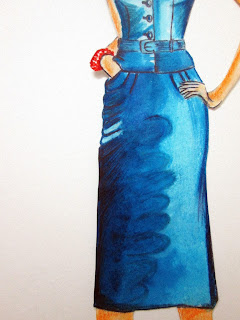Power Dressing
"Power dress" this came in existence during and after World War I, when women had to work for a living and some wanted to start a new life after losing so much in the war. They wanted a life for themselves; independence and power were their new cravings. Their lifestyle was changing, they were slowly entering previously all-men environments.

The roots of power dressing can be found in the Chanel suit of the 1920s. The Chanel suit was composed by a tight skirt and by a wool, collarless button-up jacket, usually with braid trim, metallic buttons and fitted sleeves. This suit encouraged women to try to reach their professional goals giving them comfort and mobility to fit with their independent and active lifestyles. According to the costume historian Harold Koda, the Chanel suit allowed women of the time to de-sex their feminine look and to have a more masculine appearance in order to be accepted as equals in the professional sphere.
Now I did some research on this concept, rather than just giving out the illustration of the week. So, according to Wikipedia :


The roots of power dressing can be found in the Chanel suit of the 1920s. The Chanel suit was composed by a tight skirt and by a wool, collarless button-up jacket, usually with braid trim, metallic buttons and fitted sleeves. This suit encouraged women to try to reach their professional goals giving them comfort and mobility to fit with their independent and active lifestyles. According to the costume historian Harold Koda, the Chanel suit allowed women of the time to de-sex their feminine look and to have a more masculine appearance in order to be accepted as equals in the professional sphere.
Now I did some research on this concept, rather than just giving out the illustration of the week. So, according to Wikipedia :
The concept of power dressing was brought to popularity by John T. Molloy’s manuals Dress for success (1975) and Women: dress for success (1980), which suggest a gender specific professional dress code. Molloy’s manuals addressed a new kind of female workers entering in a typical masculine environment recommending them a "uniform" that would have helped them to acquire authority, respect and power at work.
There I skipped some of the boring details (thank me later) but here comes the super
interesting fact! What all included in the "Power Dressing" dress code?


Initially power dressing consisted in a conservative style recalling directly the male wardrobe including tailored suits, jackets with padded shoulders, roll-neck sweaters and knee length skirts.
With the power dressing uniform, the female body was divided in two parts: The upper part covered by a jacket to de-emphasize breasts, the bottom covered with a skirt that was a reminder of femininity.
These outfits were usually matched with feminine accessories, discreet pieces of jewelry like pearls, diamonds, gold necklaces, earrings, scarves and ruffs.
Elaborate patterns such as floral prints were usually substituted by polka, pinstripes and hound-tooth ones. As far as colors were concerned, more sober ones such as blue, black, navy and grey were commonly preferred to feminine ones like salmon pink and red.
Don't worry the suit has had a great revolution after that!
It's 21st century and here comes the super sexy, powerful and commanding suits:
Don't worry the suit has had a great revolution after that!
It's 21st century and here comes the super sexy, powerful and commanding suits:
| There's definitely inclusion of pink, women are established in politics and business and can make their own rules and dress codes! |
There, I gave you guys some more work wear inspiration plus a history of work wear evolution!
Illustration of the week:
 |
| Shoe details! |
One more thing..
If you could share the post, it would be a great deal for me. I love my readers and more than that I love art lovers so if you value the efforts, please share! It takes no time ;)
If you could share the post, it would be a great deal for me. I love my readers and more than that I love art lovers so if you value the efforts, please share! It takes no time ;)








Comments
Post a Comment